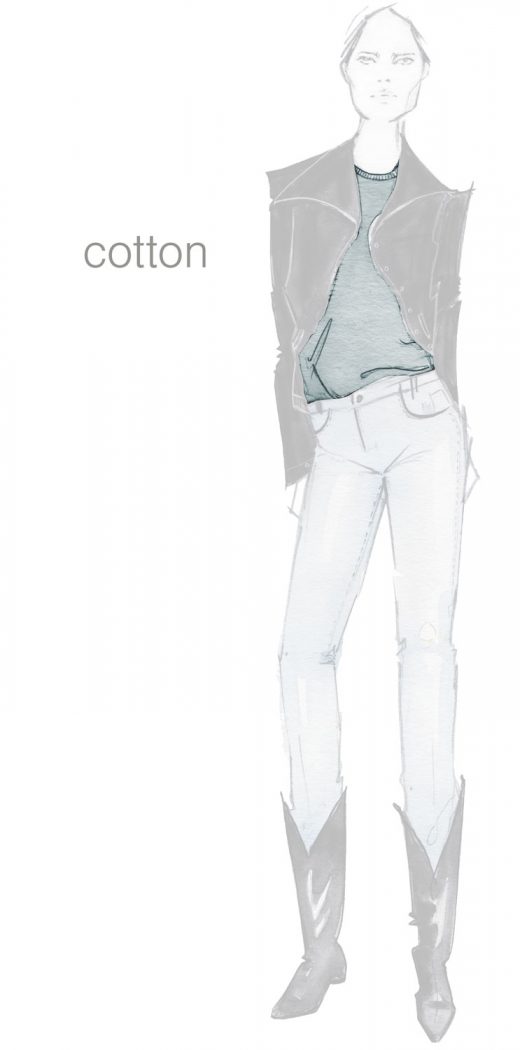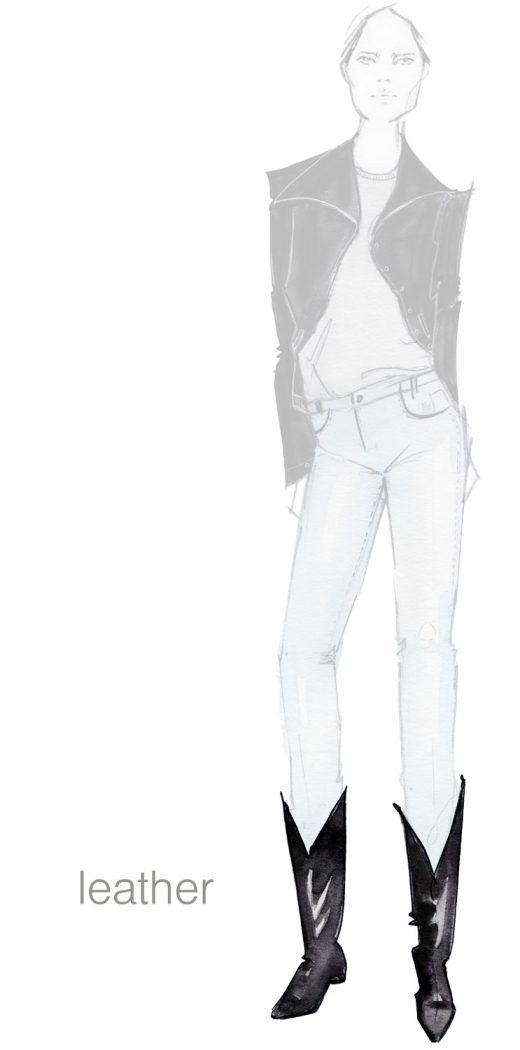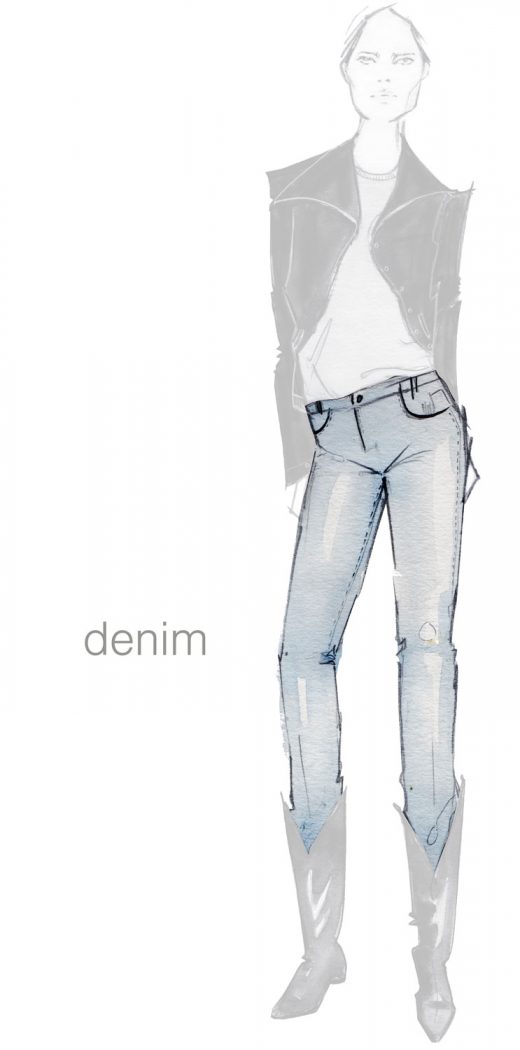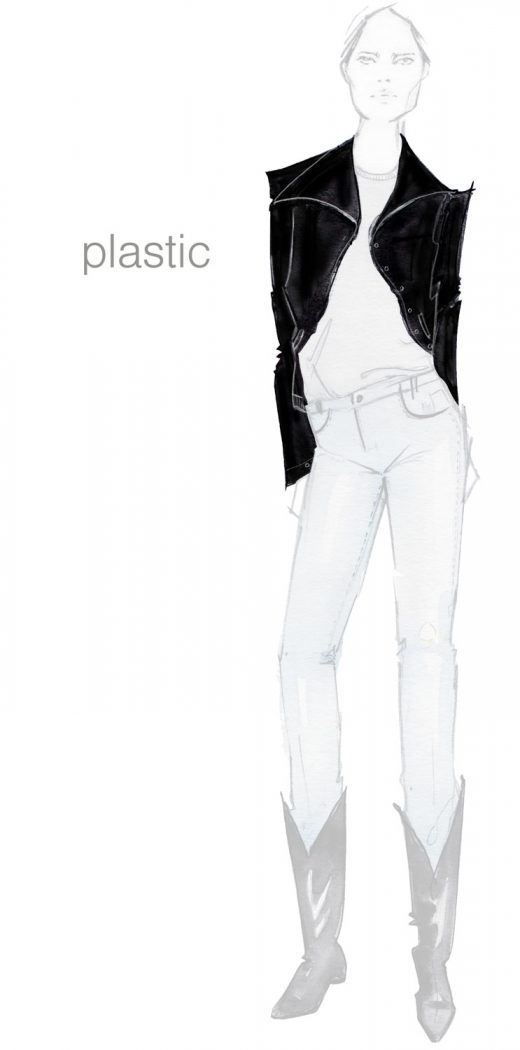Saving the Ocean One Outfit at a Time
The sea suffers for fashion. Kombucha leather and leased jeans to the rescue.
Article body copy
Around the world, people buy about 80 billion new garments a year, and Americans alone throw out 15 million tonnes of clothing. Global fast-fashion companies are having a heyday, with Zara owner Inditex and Swedish giant H&M posting massive sales and regularly ranking on Forbes’s list of most-profitable fashion companies. Clothes have never been cheaper, and anyone can look like an Instagram fashionista or a GQ model for the cost of a couple of medium pizzas.
But this disposable fashion is the result of a global supply chain that hides the true cost of garments. While many companies tout their environmental responsibility, follow their supply chains far enough and you’ll find a labyrinth of independent mills and factories where fabric is woven, dyed, and sewn under sometimes-abysmal conditions. As a rule, fashion companies don’t own these factories, and may not even have direct contact with them, limiting their influence. Above all, these supply chains are nimble. If labor or environmental regulations tighten up in one place, as happened in Cambodia in 2017, buyers may just shift to a cheaper, more competitive locale.
Here at Hakai Magazine, we’re taking a closer look at the impacts of fast fashion on our oceans and rivers. It turns out that a few keystone materials in those fall lookbooks spell particular trouble for the coast.
Cotton
Over a garbled Skype connection, Shafiq Ahmad speaks of a time when people could drink the groundwater near his home in Pakistan. “But now we can’t use it,” Ahmad says. The water is unsafe, and the culprit, he says, is runoff from crops contaminated with pesticides. One of those crops is cotton, which can be found in a large proportion of fast-fashion garments.
Ahmad is Pakistan’s country manager for the Better Cotton Initiative (BCI), an NGO that works with farmers on the ground to fix some of the environmental issues related to cotton agriculture. One major issue is the impact the crop can have on the region’s water.
Textiles and cotton farming are big industries in Pakistan. The country is the world’s fourth-largest cotton producer after China, India, and the United States. Pakistan’s cotton crop consumes close to 20 trillion liters of water—equivalent to the capacity of more than eight million Olympic swimming pools—every year from the country’s lifeblood, the Indus River.
And the Indus is in trouble.
The river is born in the glaciers that cloak the mountain ranges north of Pakistan, the Himalayas and the Karakoram. From there it flows southward into Pakistan, where barrages and dams capture the precious water and divert it into tributaries and canals heading toward communities and farms. A staggering 75 percent of the Indus River’s water goes to canals for farming. By the time the river reaches its delta, it’s barely a trickle.
When the first industrial-scale dams were opened on the Indus in the mid-20th century, they sharply reduced the flow of water and sediment that continually replenished the Indus’s huge delta. Deprived of material, the sea began eroding the delta, up to 12 square kilometers per year since 1944. Salty water has pushed dozens of kilometers inland. Farmers and fishermen in the once-lush delta have witnessed the consequences of the sea’s incursion—the disappearance of the mangroves and freshwater fisheries that rely on mangroves for habitat. Meanwhile, climate change shrinks the Himalayan glaciers that supply the Indus, and increases the frequency and severity of drought in Pakistan.
The “water wars” hypothesis appears not so farfetched. As fresh water becomes scarcer around the world, it will become more precious and conflict over it will lead to violence, much as valuable oil contributed to conflicts such as the Gulf War. Cotton is far from the sole cause of the Indus’s woes. But it does need a lot of water and it’s become deeply interwoven with Pakistan’s economy, with hundreds of thousands of people relying on cotton and textiles for a living.
This advertisement shows some of the pesticides that are sprayed on cotton in Pakistan.
Ahmad explains that one solution is to rethink Pakistan’s irrigation infrastructure. With open canals instead of closed conduits, about half of the water flowing from catchments to farms makes it to the farmer. The rest is lost to evaporation. And in farms without modern irrigation infrastructure, irrigation means just flooding the field, which increases evaporation and contaminated runoff.
BCI’s farmers now grow 12 percent of the world’s cotton. They say they have reduced water use in Pakistan by 21 percent and pesticide use by 17 percent, and increased profits by 37 percent. BCI also works in the largest cotton producing countries, China and India, but neither these two countries nor the United States is facing as dire a water management situation as Pakistan.
“The biggest challenge for us is governance of water and distribution of water,” Ahmad says, adding that the river is misused by many parties. Those who are allocated a lot of water from the catchment basins and canals often waste it; if farmers then find themselves without enough water, they may pump more illegally from the ground, lowering the already polluted water table. Pumping a water source dry for cotton has precedent: north of Pakistan, the Aral Sea—drained for irrigation during the Soviet era—stands as witness that even the largest fresh watersheds can be mismanaged to decimation.

The Aral Sea in Central Asia was once the fourth-largest lake in the world. When Soviet-era plans to intensively grow cotton in the region called for irrigation, the lake began to shrink. Today, it’s barely a puddle, and sometimes it’s entirely dry. Photo by NASA
Leather
In North America, people often own more leather than they realize or care to admit. Closets are typically stuffed with footwear, from Blundstones and Birkenstocks to Keens, Adidas, and Doc Martens. In the United States alone, consumers spend nearly US $30-billion annually on footwear, and that figure doesn’t include what families dish out each year for many other leather goods, including handbags, gloves, and jackets.
All these purchases drive a global leather industry with tentacle-like supply chains that many of us rarely think about. Between 2012 and 2014 alone, the world’s manufacturers produced nearly 1.8 billion square meters of lightweight leather (both bovine and sheep leathers) for the fashion industry, almost enough to blanket the Hawai‘ian island of Maui. Much of this fine leather came from small tanneries in developing countries, where labor costs are rock bottom, and environmental and workplace health regulations are often poorly enforced. So what’s the true cost of our love of fashionable leather?
Look at Bangladesh, a land of meandering rivers and tropical floodplains along the Bay of Bengal. In 2016, more than 200 tanneries vied for space in a teeming industrial quarter in the capital city of Dhaka, along the floodplain of the Buriganga River. To transform perishable animal skin into durable leather, factory workers soaked animal hides in a series of toxic baths containing nearly 40 different acids and several heavy metals including chromium, a known carcinogen. The hides absorbed just 20 percent of these chemical brews: the rest was waste. In all, Dhaka’s tanneries discharged nearly 22,000 cubic liters of toxic effluent daily into the Buriganga River, which ultimately flows into the Bay of Bengal.
Under this chemical onslaught, the Buriganga River is dead. The water smells like rotten eggs and is devoid of oxygen, Imamul Huq, an environmental scientist and vice chancellor of the University of Barisal in Bangladesh, notes in an email. “No aquatic life exists in the river,” Huq adds. (In addition, a 2016 study reports that more than 200 kilometers away, some ocean shores in eastern Bangladesh are now polluted with heavy metals from tanneries and other industries in the Chittagong region.) Faced with an environmental disaster along the floodplain of the Buriganga River, the Bangladeshi government forced Dhaka’s leather factories to move to a new industrial park in 2017, and it has promised to install an effluent treatment plant there. But the opening of the plant was delayed, and in February, residents raised fears that the transplanted tanneries were contaminating a second river, the Dhaleshwari.
Nearly 200 leather tanneries once crowded into the neighborhood of Hazaribagh, in the Bangladeshi capital of Dhaka. The polluted water there emitted a terrible stench. In 2017, the Bangladeshi government moved the tanneries to a new industrial park and it has promised to build a major water treatment plant.
Other developing countries face similar problems. In China, untreated tannery wastewater has poisoned the Hutuo River, turning it into a channel of toxic sludge. And in the Philippines, tannery effluent and other industrial wastewater discharged into the Marilao River has contaminated some shellfish beds in Manila Bay.
There’s plenty of incentive to produce a more river- and ocean-friendly leather. In Bangladesh, engineers are test driving technologies for reducing water consumption and chromium use in tanneries. Others are looking for sustainable alternatives to leather. Some fashion companies offer goods made from “vegan leather,” a synthetic mainly composed of polyurethane (PU) or polyvinyl chloride (PVC). No animals are slaughtered to produce this synthetic leather, but PU and PVC have both been linked to serious health and environmental problems. PU and PVC factories often use a solvent known as dimethylformamide—a carcinogen that exposes workers to increased risk of testicular and oral cavity cancer. In addition, studies show that PVC leaches dioxins in landfill sites.
So researchers are now searching for cleaner alternatives. In New Jersey, scientists at the American firm Modern Meadow are attempting to mass produce collagen—the protein in animal skin—from living cells, so they can biofabricate leather for the fashion industry without killing any animals. Elsewhere, research teams are experimentally producing a form of leather from a popular drink stocked in many grocery stores—kombucha.
Kombucha is made by stirring sugar, bacteria, and yeast into black or green tea: as the mixture ferments, it forms long fibers of cellulose. In Australia, Alice Payne, a lecturer in fashion at Queensland University of Technology, and her colleagues and students have experimentally cultured kombucha leather and designed fashionable apparel from it. By allowing the kombucha mixture to ferment for two to three weeks, the Australian researchers created a pliable skin-like membrane 10 millimeters thick that looked a little like tofu. It was slimy, but it had the texture of leather. Once the team members washed, oiled, dried, and sealed the material, they fashioned handbags, clothing, and footwear from it. The “shoe styles vary from casual slip-ons to more conceptual designs with handmade wooden heels and soles,” Payne and her colleagues noted in a 2016 paper.
Researchers are now attempting to create sustainable alternatives to leather. In Australia, researchers have produced a pliable leather-like material from a raw material found in many grocery stores: kombucha. They say it’s dead simple to make.
But kombucha leather isn’t ready for the fashion industry. “Growing a consistent piece is difficult,” notes Payne in an email. And kombucha leather, she adds, is less durable than animal leather. To encourage other innovators to help solve the problems and pave the way to commercialization, Payne and her colleagues have posted online simple instructions for making this sustainable material. In decades to come, kombucha leather could be a promising alternative to animal hides.
Denim
What looks more comfortable, down to earth, and innocuous than a pair of well-worn jeans? With their traditional design and 19th century watch pocket, blue jeans seem to come from an earlier, simpler time. But the blue jean industry has become something of an environmental battleground today. Jean factories frequently produce the trademark blue color by soaking cotton a dozen or so times in giant vats containing a synthetic indigo dye often produced from fossil fuels. And the artfully faded look, known as stonewash? It comes from workers blasting the fabric with silica or stripping the dye with toxic chemicals rich in heavy metals.
Like tanneries, denim factories are often located in the developing world—out of sight, and out of mind of Western consumers. One of the world’s biggest producers of denim is a gritty looking city in China’s Pearl River Delta—Xintang. According to one 2016 study, Xintang’s factory workers produce a whopping 200 million pairs of jeans a year, but they and their neighbors pay a steep price for the industry.
The local river has turned a strange black color from the dumping of untreated dye water from the factories. And scraps of denim and other factory sludge rot along riverbanks. In 2010, Greenpeace researchers conducted a study in Xintang and neighboring Gurao, sampling water and sediments from the river. Nearly 80 percent of the samples were contaminated with heavy metals. One sample contained a level of cadmium, a heavy metal toxic to humans and aquatic life, that was 128 times greater than the limit set by the Chinese government. “Not only are the substances in the wastewater poisoning aquatic systems and depleting fish stocks,” writes Kim Hiller Connell, an environmental scientist at Kansas State University, in a 2015 book chapter, Xintang’s jean factories are dumping their effluent “into water utilized by millions of people.”
Today, research teams are working on new dying technologies that use much less water: one such system alters the molecular structure of cotton fibers so they absorb dye more readily. This reduces the use of water by 90 percent. But some fashion designers aren’t waiting for scientific fixes. Mud Jeans, for example, is going the sharing economy route, with its Lease A Jeans program. In this model, the consumer rents a pair of Mud jeans by paying a one-time €20 (US $24) membership fee and a monthly fee of €7.50 for 12 months: any time after that, the buyer can send back the old jeans and lease a new pair, paying the same monthly fee. Meanwhile the company recycles the worn-out jeans: workers cut them into pieces, mechanically extract the fibers, and produce new articles of clothing.
Far removed from Western consumers, many denim factories in China and other developing countries are polluting rivers by releasing dyes and other harmful chemicals into the water. Now fashion companies are working on a more sustainable denim industry, by leasing jeans to consumers and taking them back later to be recycled.
“This is moving in the right direction—leasing, repairing, lending,” says Kirsten Brodde, who leads the Detox My Fashion campaign for Greenpeace Germany. “All these small companies are paving the way. They are the business models for tomorrow.”
Plastics
By the time we thought to look, they were everywhere. Tiny squiggles of plastic, almost too small to detect with the naked eye. These plastic microfibers are scattered throughout the ocean, from the surface to the bottom and everywhere in between. When washed, synthetic garments such as acrylic, polyester, and fleece shed microfibers, which end up in the ocean through wastewater discharge. Indeed, of all the microplastics that wash up on coastlines around the world, more than 85 percent are fibers, outnumbering other types such as microbeads from cosmetics or shards broken down from larger plastic pieces. So, how bad are they?
Unlike plastic bags or bottle caps, quantifying what these ubiquitous fibers do to marine fauna is tricky. “In the real world, it’s impossible to see if it’s causing harm,” says Peter Ross, director of the Ocean Pollution Research Program at Ocean Wise Conservation Association.
According to Ross, it’s also unclear how much harm microfibers would do to a human who ingests them. But lab tests show how these fibers can be a serious problem at the lower end of the ocean’s food chain.
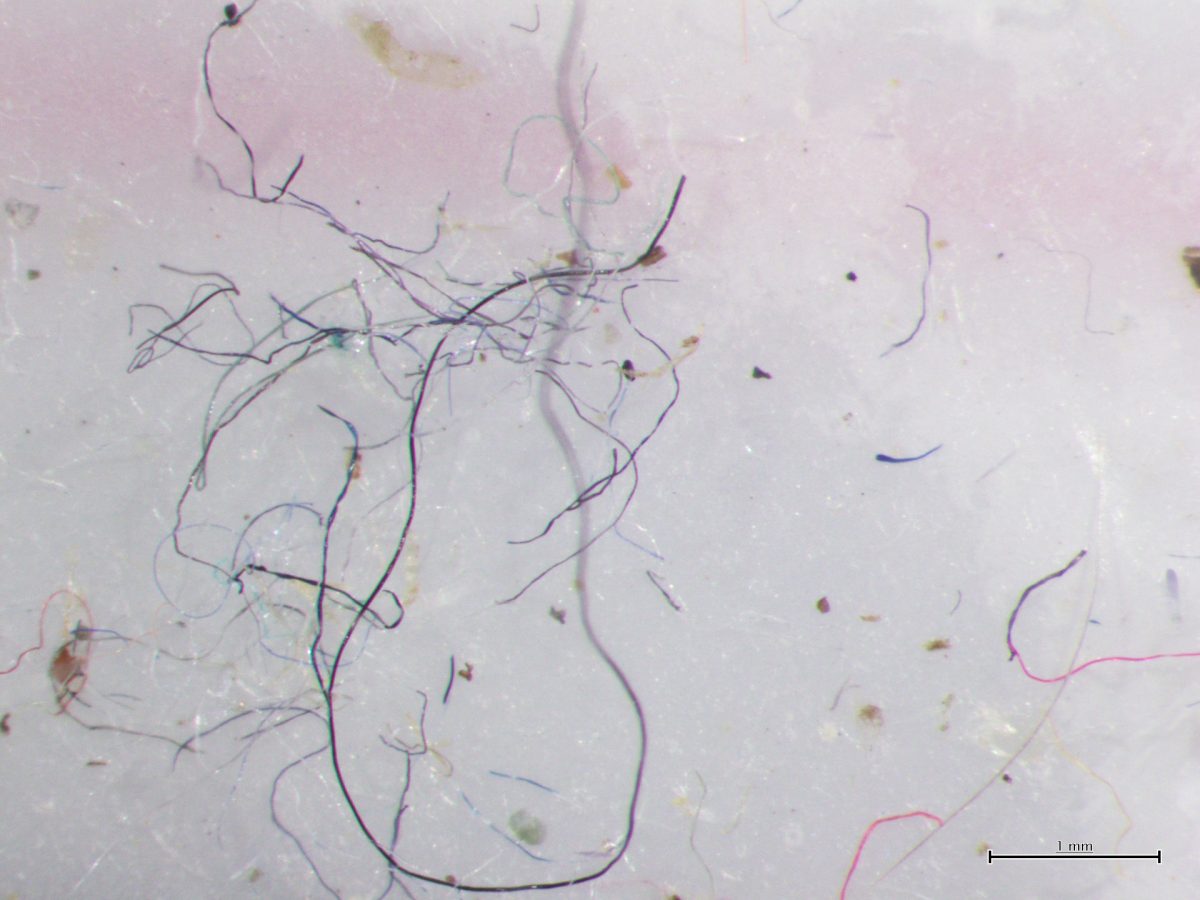
These microfibers are ubiquitous in the ocean, from the deepest waters to the surface waves. Photo courtesy of the Ocean Wise Conservation Association
“We know plastics create blockages and suffocate large animals,” Ross says. He thinks the same could be happening to little marine organisms. Research from 2013 on copepods—a kind of zooplankton—exposed to microplastic beads found that the plastic stuck to the animals, and when they ate the plastic, it obstructed their guts making it difficult to eat anything else. This supports the idea that microplastics may choke zooplankton. Microfibers could then work their way up the food chain, as larger animals gobble up the plastic-stuffed zooplankton.
Marine biologist and Hakai Institute researcher Sarah Dudas says oysters on Vancouver Island, British Columbia, are already harboring microplastics. They can filter them out within about five days, but only after they are exposed to a continuous stream of super-clean seawater, which is unrealistic in today’s ocean. Microfiber impacts are more than physical, they’re chemical, too. Like any other plastic, they can leach their composite chemicals into animals that have eaten them. And other pollutants can stick to plastic microfibers and poison animals too, though this has not been well studied. But any effort to get rid of them requires knowing where the fibers are coming from, a difficult proposition. Once they are swirling about in the ocean, there’s no way to tell what city, or type of garment, was the point of origin.
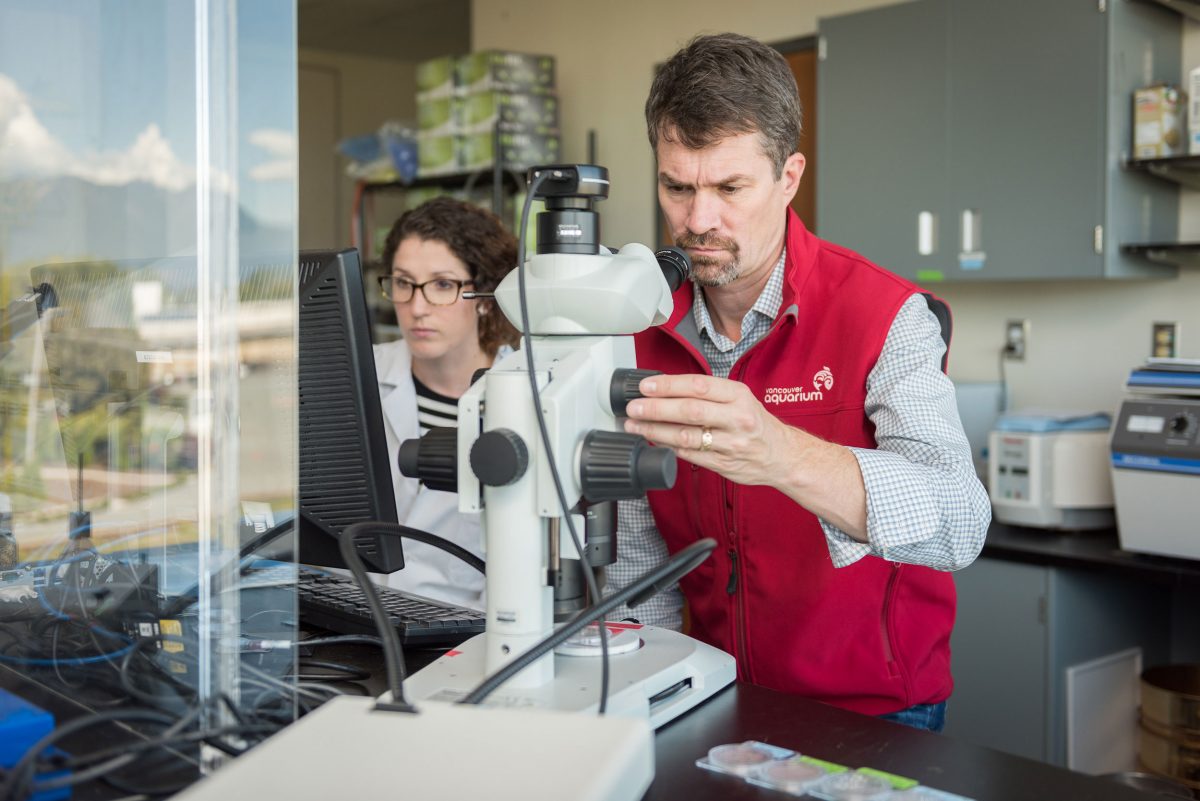
Peter Ross examines microfibers. By examining the unique chemical signatures of different kinds of fibers, he hopes to help narrow down where the microfibers come from in any given sample of seawater. Photo courtesy of the Ocean Wise Conservation Association
To find out, Ross is washing clothing with known components in standard washing machines, and then categorizing the chemical and physical signatures of the fibers. He hopes to create a library of fibers, from acrylics to polyester. Then Ross and his colleagues could test ocean water samples from around the world and measure their chemical signatures against the database to determine where the fibers came from. If a lot of microplastics of a certain kind appears in one place, for example, efforts to stop the source can be focused and, hopefully, effective.
Ross is partnering with Metro Vancouver and outdoor apparel companies MEC and REI to do this. Outdoor clothing is a big source of synthetic fibers. Yet while high-end apparel companies have an incentive to market better products to green-minded consumers, that’s not true of lower-end companies that focus on selling high quantities at low prices. The volume of microfibers washing onto shores, and finding their way into animals, including humans, may be high for a while yet.


